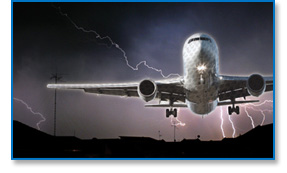
Aircraft Lightning Strike Protection
- Lightweight & Flexible
- Single unit structure won't unravel
- Controlled open area conductivity to 200,000 amps
Composites & Dexmet Lightning Strike Protection
Aluminum has been the principal material used in aircraft and aerospace construction for the past 60 years. With the growing interest to construct more efficient aircraft, manufacturers are designing more components out of light-weight composite materials. Current composite structures include engine nacelles, flaps, wing tips, and even rotary blades on helicopters and wind turbines. Composites, however, are poor conductors of electrical current. Without proper protection, they are susceptible to severe damage in the event of a lightning strike. When Dexmet expanded aluminum and copper MicroGrid materials are incorporated into the surface of these composite structures, the lightning strike energy is dissipated over the surface of the component, which prevents damage to the composite material below.
MicroGrid precision expanded metal foils from Dexmet are the materials of choice for lightning strike protection in composite aircraft structures. Dexmet is the exclusive supplier for Boeing, principle supplier for Embraer, and preferred vendor to a majority of aircraft manufactures around the world. Aircraft manufacturers are quickly realizing the benefits of using Dexmet's advanced expanded materials over the outdated technology of woven wire.
MicroGrid's single unit structure is superior to woven material in that it won't unravel or have loose strands that become problematic during processing into a pre-preg material or when conducting a dry lay-up. The homogenous deisgn also ensures uncompromised conductivity between strands when forming the material to a variety of shapes and contours and provides a smooth surface on the end product. MicroGrid's biggest advantage is Dexmet's ability to tightly control the manufacturing process to meet a specific weight, open area, and conductivity requirement. This allows Engineers the option of varying materials according to specific strike zones on the aircraft, minimizing the overall weight. Our common materials have the ability to withstand a Zone 1A stirke of 200,000 amps.
When viewing the Charts section you can compare commonly processed materials for lightning strike protection in composite aircraft structures. Other alloys, metals, thicknesses and pattern sizes are available.












